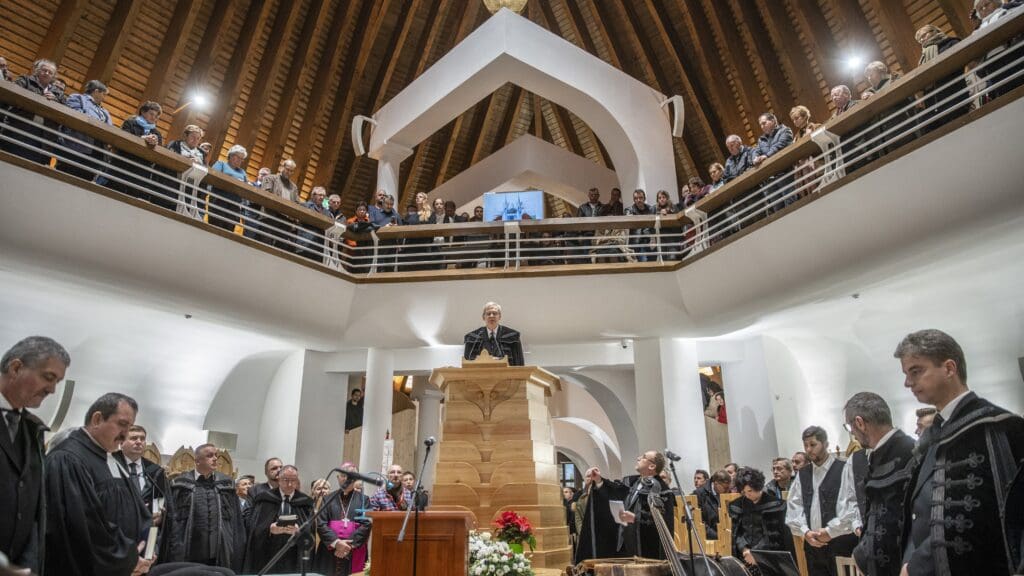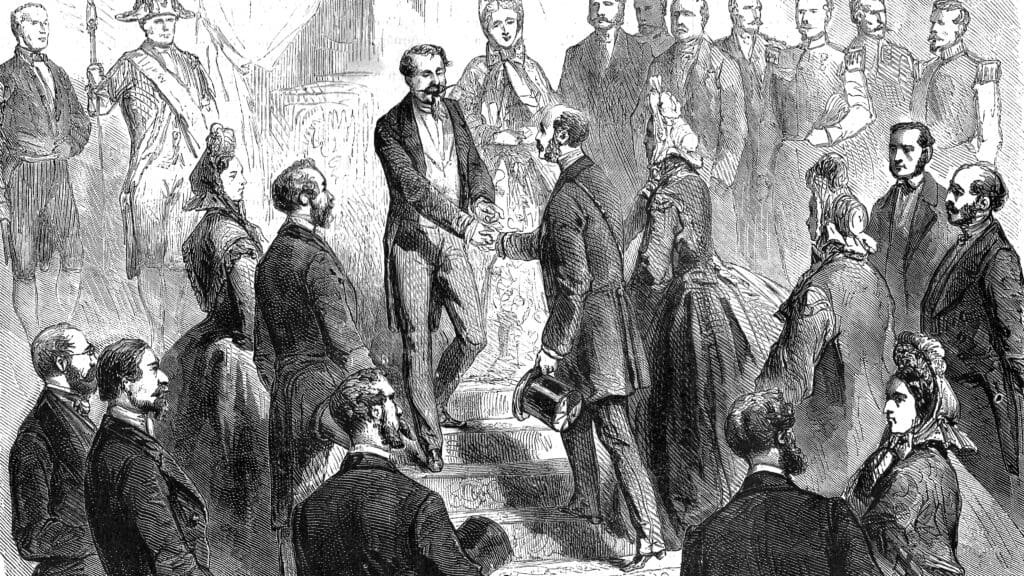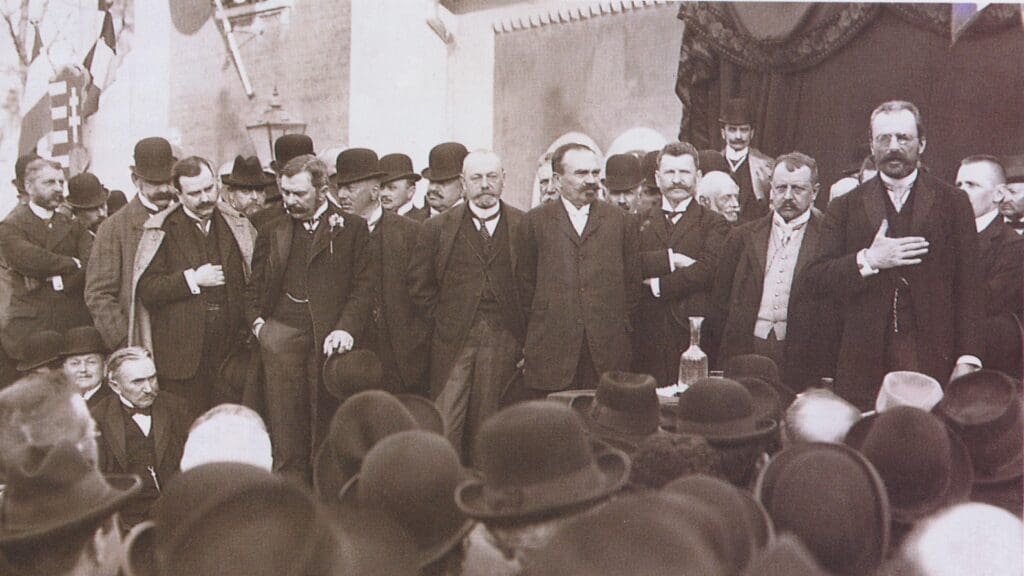
The Second Hungarian Army, during the autumn and winter of 1942, prepared to hold up the incoming Soviet offensive coming from the direction of Stalingrad. As the Germans lost the siege of the city in all but theory, it was practically sure that the Soviets would advance toward the River Don. Thus, the Hungarian troops were left to defend the bridgeheads from the Soviets, who outnumbered them seven to one.

The catastrophe of the Second Hungarian Army at the River Don is a well-known and traumatic memory for most Hungarians. The army formation was deployed near Stalingrad, and was almost entirely destroyed by the Soviets in 1943, leaving many Hungarian families with deceased relatives.

On Christmas Eve in 1944 the Soviet troops encircled Budapest, and the siege commenced a few days later, on 30 December. The fighting that went on for months caused enormous suffering and destruction, and became part of Hungary’s collective memory forever.

The tragic fate and bravery of Gusztáv Jány, Commander of the Hungarian Second Army, mirror those of his troops, and, in many ways, of Hungary itself.

The First World War is known as the first dreadful and devastating armed conflict that engulfed almost the entire world. However, a chain of events during the December of 1914, known as the ‘Christmas truce’, showed that humanity and brotherly love could prevail over the senseless killing, if only for a brief time.

‘The mamaliga (a typical Romanian boiled cornmeal dish) will not explode,’ Communist dictator Ceaușescu famously said in the 1980s, dismissing the potential of the forces that opposed him. But the discontent with the oppressive regime had been brewing for a long time by then, so the sparkle represented by the brave resistance of Hungarian Reformed pastor László Tőkés and his flock was enough to light the fire of the revolution all across Romania.

József Mindszenty is often commemorated as one of the first victims of the Rákosi regime. However, his 1949 arrest and show trial were not the last stage of his ‘white martyrdom’: he spent one and a half decades as an asylee at the US Embassy in Budapest, only to be exiled from the country for good in 1971.

Cardinal Mindszenty played an important role in the 1956 revolution. He assumed his post as archbishop immediately after his release from captivity, appealed for international aid for Hungary, initiated the process of cleaning the church from Communist infiltration, while also being active in the political life of the country. Firmly holding onto his conservative view of himself as the most important dignitary of Hungary, he tried to set the direction of the course of events. Contrary to the recent myth-busting efforts, this direction was not reactionary or outdated.

In 1864, Maximilian of Austria arrived in Mexico, assuming the throne of the country. He was declared emperor of Mexico as Maximilian I. Although this was only one, and quite brief, episode in his eventful life, it was the most memorable one, and the one that turned out to be fatal.

Mexico and Hungary are connected not only by their similar flag colours, or their shared love for hot and spicy food. Their histories also intersected multiple times, one example being when a Habsburg archduke briefly ruled the Latin American nation.

Sándor Wekerle was born 175 years ago in 1848. While being one of the most remarkable and enlightened Hungarian politicians of the Compromise era, he was largely exiled from history in the twentieth century.

16 November marks the day when Rear Admiral, and later Regent, Miklós Horthy marched into Budapest in 1919, symbolically ending the Hungarian Soviet Republic. This remains a controversial event to this very day: while on the one hand, it ended a period of chaos and dictatorship, on the other hand, it bolstered the so-called White Terror.

The Houthi movement of Yemen has recently declared its support for Hamas in the Gaza conflict. What connects the Houthis, Hezbollah and Hamas is their backing by Iran.

The events of the 1956 Revolution are quite well-known, at least in Hungary, as far as the beginning of it and the period of its brief triumph are concerned. What is less known is that the revolution was not fully suppressed on the day of the Soviet invasion on 4 November. Active, armed resistance lasted until 11 November, and civil disobedience, as well as sporadic outbursts of rebellion kept the Soviets from stabilizing their rule until the late spring of the next year.

On 4 November 1956, the fate of the Hungarian Revolution of 1956 was sealed as Soviet troops entered the country to crush the uprising.

The recent outbreak of violence in the Middle East may soon lead to the opening of another front, where Israel would clash with Hezbollah. But what is this Lebanese Shia organization, and how did it come to be?

‘For Gyula Tellér, humanity, nation, education, and critical thinking were the core values. First and foremost, he believed in humanity, as well as in civilization and its achievement. He believed in the human being as an individual who is able to contribute to society, and who takes responsibility for his own actions.la

With the brutal terrorist attack on Israel, Hamas came to spotlight in the news. In this article, we look at the origins and the ideology of the Palestinian terrorist organization that committed the abominable massacre of Israeli civilians.

Pál Teleki, prime minister of Hungary in the interwar era, was probably one of the most tragic figures of twentieth century Hungarian history. He was torn between his conscience and geopolitical reality, a tension he could only resolve by ending his own life as a shocking act of protest.

Israel have always had few allies in the Middle East in its fight for self-preservation. However, one small ethnoreligious group is an exception. The Druze have sided with the Jewish state ever since its inception, adhering to a ‘covenant of blood’ between Jews and the Druze.

On 7 October, the terrorist group Hamas commenced the largest and bloodiest attack against Israel since the Yom Kippur War. In many ways, the aggression echoes not only the 1973 war, but also the al-Qaeda terrorist attacks on the US as well.

The question of a language strategy, and the need thereof, are important and highly debated topics in linguistics these days. Linguist, university professor Géza Balázs contributes to this debate with an insightful essay in the recent issue of conservative journal Kommentár.

The Afghanistan War started exactly 22 years ago. Two years after it came to an end, our analysis looks back at the invasion and the botched nation-building, attempting to pinpoint the reasons of the ambitious project’s failure.

The 13 martyrs of the 1848–49 Hungarian War of Independence are commemorated on 6 October every year. However, the struggle for independence had other, forgotten heroes, too, like General János Lenkey, the ‘14th martyr of Arad’.

‘Nachtmann argues that due to the important role the state had in Hegel’s thinking, it can be described as having both right-wing and left-wing components. It, however, stands in stark opposition to liberalism.
For liberals, the individual is a phenomenon standing alone by itself, envisioned as isolated. However, for Hegel, individuals only existed as part of the community, family, and nation.’

István Bethlen was a dominant figure in early twentieth-century Hungarian politics. Contemporary conservatives have much to learn from him regarding consolidation, pragmatism, and opposing radicalism.

Count István Tisza is still blamed by liberal and left-wing historiographers for Hungary entering WWI, despite clear evidence of his anti-war stance. It is rather anachronistic to hold Tisza to democratic standards that did not exist at the time and with the wisdom of hindsight: the knowledge of how the war ended.

After the Polish government decided to extend their ban on Ukrainian grain imports on Wednesday, the Hungarian agricultural minister also announced that Hungary will continue to keep Ukrainian grain and several other agricultural products out of the country to protect local farmers. UPDATE: The prohibition of the import of the Ukrainian products in question was published in the Hungarian Gazette after Brussels lifted the grain ban last night.

Speaking about both past and future efforts, the Hungarian prime minister identified five key targets in Hungary’s family policy: incentivizing childbirth; aiding home ownership; prioritizing mothers in family policy; promoting family-friendliness nationwide; and ensuring legal protection for families.

According to Hungarian Defence Minister Kristóf Szalay-Bobrovniczky, Hungary and Georgia’s cultural similarities make the bilateral dialogue easier. Both nations speak a unique language, have a ‘closed culture’, and are committed to the values of Christianity, he stressed.